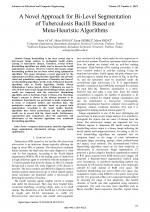| 1/2018 - 14 |
A Novel Approach for Bi-Level Segmentation of Tuberculosis Bacilli Based on Meta-Heuristic AlgorithmsAYAS, S. |
| View the paper record and citations in |
| Click to see author's profile in |
| Download PDF |
Author keywords
computer aided analysis, heuristic algorithms, image segmentation, information entropy, particle swarm optimization
References keywords
tuberculosis(12), thresholding(10), segmentation(10), image(10), images(8), algorithm(7), algorithms(6), yang(5), sputum(5), method(5)
Blue keywords are present in both the references section and the paper title.
About this article
Date of Publication: 2018-02-28
Volume 18, Issue 1, Year 2018, On page(s): 113 - 120
ISSN: 1582-7445, e-ISSN: 1844-7600
Digital Object Identifier: 10.4316/AECE.2018.01014
Web of Science Accession Number: 000426449500014
SCOPUS ID: 85043229405
Abstract
Image thresholding is the most crucial step in microscopic image analysis to distinguish bacilli objects causing of tuberculosis disease. Therefore, several bi-level thresholding algorithms are widely used to increase the bacilli segmentation accuracy. However, bi-level microscopic image thresholding problem has not been solved using optimization algorithms. This paper introduces a novel approach for the segmentation problem using heuristic algorithms and presents visual and quantitative comparisons of heuristic and state-of-art thresholding algorithms. In this study, well-known heuristic algorithms such as Firefly Algorithm, Particle Swarm Optimization, Cuckoo Search, Flower Pollination are used to solve bi-level microscopic image thresholding problem, and the results are compared with the state-of-art thresholding algorithms such as K-Means, Fuzzy C-Means, Fast Marching. Kapur's entropy is chosen as the entropy measure to be maximized. Experiments are performed to make comparisons in terms of evaluation metrics and execution time. The quantitative results are calculated based on ground truth segmentation. According to the visual results, heuristic algorithms have better performance and the quantitative results are in accord with the visual results. Furthermore, experimental time comparisons show the superiority and effectiveness of the heuristic algorithms over traditional thresholding algorithms. |
| References | | | Cited By |
Web of Science® Times Cited: 4 [View]
View record in Web of Science® [View]
View Related Records® [View]
Updated today
SCOPUS® Times Cited: 3
View record in SCOPUS® [Free preview]
View citations in SCOPUS® [Free preview]
[1] RUN: rational ubiquitous navigation, a model for automated navigation and searching in virtual environments, Raees, Muhammad, Ullah, Sehat, Virtual Reality, ISSN 1359-4338, Issue 2, Volume 25, 2021.
Digital Object Identifier: 10.1007/s10055-020-00468-0 [CrossRef]
[2] Tuberculosis Disease Diagnosis Based on an Optimized Machine Learning Model, Hrizi, Olfa, Gasmi, Karim, Ben Ltaifa, Ibtihel, Alshammari, Hamoud, Karamti, Hanen, Krichen, Moez, Ben Ammar, Lassaad, Mahmood, Mahmood A., Li, Xingwang, Journal of Healthcare Engineering, ISSN 2040-2309, Issue , 2022.
Digital Object Identifier: 10.1155/2022/8950243 [CrossRef]
Disclaimer: All information displayed above was retrieved by using remote connections to respective databases. For the best user experience, we update all data by using background processes, and use caches in order to reduce the load on the servers we retrieve the information from. As we have no control on the availability of the database servers and sometimes the Internet connectivity may be affected, we do not guarantee the information is correct or complete. For the most accurate data, please always consult the database sites directly. Some external links require authentication or an institutional subscription.
Web of Science® is a registered trademark of Clarivate Analytics, Scopus® is a registered trademark of Elsevier B.V., other product names, company names, brand names, trademarks and logos are the property of their respective owners.
Faculty of Electrical Engineering and Computer Science
Stefan cel Mare University of Suceava, Romania
All rights reserved: Advances in Electrical and Computer Engineering is a registered trademark of the Stefan cel Mare University of Suceava. No part of this publication may be reproduced, stored in a retrieval system, photocopied, recorded or archived, without the written permission from the Editor. When authors submit their papers for publication, they agree that the copyright for their article be transferred to the Faculty of Electrical Engineering and Computer Science, Stefan cel Mare University of Suceava, Romania, if and only if the articles are accepted for publication. The copyright covers the exclusive rights to reproduce and distribute the article, including reprints and translations.
Permission for other use: The copyright owner's consent does not extend to copying for general distribution, for promotion, for creating new works, or for resale. Specific written permission must be obtained from the Editor for such copying. Direct linking to files hosted on this website is strictly prohibited.
Disclaimer: Whilst every effort is made by the publishers and editorial board to see that no inaccurate or misleading data, opinions or statements appear in this journal, they wish to make it clear that all information and opinions formulated in the articles, as well as linguistic accuracy, are the sole responsibility of the author.





